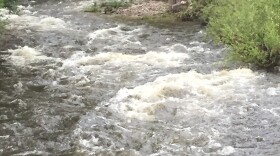Some of the water from the Roaring Fork watershed follows the usual route, from high peaks down to the Colorado River. But much of the snowmelt and rain from this basin is redirected to water-starved cities on the Front Range. Aspen Public Radio’s Elizabeth Stewart-Severy joined a rare tour of the tunnels that move water to the other side of Independence Pass.
A few people every year stand in a puddle in the dark and peer four miles down a tunnel to see a pinprick of light. This tunnel runs from Grizzly Reservoir, under the mountains to just below the closure gate on the Twin Lakes side of Independence Pass. It’s normally filled with water from the Roaring Fork watershed, but that water is owned by municipalities on the eastern slope.
Glenn Schryver and his wife Kim are caretakers for the Twin Lakes Reservoir and Canal Company and live at Grizzly Reservoir, about 6 miles up a rough dirt road from the Lincoln Creek campground turnoff on Independence Pass.
“It’s a great job. You know, I know there’s a lot of politics, which we really don’t have to do with any of it,” Schryver said. “We just work for people and have the best job in the world, really.”
That job includes clearing out debris from ditches and canals, setting and monitoring gauges, inspecting the tunnels, and taking direction from the Twin Lakes Reservoir Company about how much water to send through the mountain.
Liza Mitchell with the Roaring Fork Conservancy spent an afternoon with a high school Experiential Education (Ex Ed) class, teaching students about watersheds. This is her go-to metaphor: Imagine that the Roaring Fork Valley is a giant bathtub. Water that falls on any side of the basin eventually makes it to the drain — the Colorado River.
“Now when we take water across the Continental Divide, it’s like taking your shower head and spraying outside of the bathtub,” Mitchell said. “That water is never coming back into the bathtub and going down the drain.”
Those students learned about the transbasin diversions in the Roaring Fork Valley, but through tunnels rather than showerheads. They toured two of those tunnels, and the lakes, streams and canals that feed into them on Independence Pass.
Up to 625 cubic feet per second (CFS) rushes through the Twin Lakes Tunnel. It can be hard to visualize CFS; one cubic foot is about the same size as a basketball, so 625 CFS would be kind of like 625 basketballs rushing past you every second, for about two weeks during peak runoff. And here, it’s flowing through a 9-foot diameter concrete pipe through the mountain.
The water pours out into Lake Creek and is stored in Twin Lakes. From there, it’s divided among several east-slope cities, including Colorado Springs, Pueblo, and Aurora. Rick Kienitz works for Aurora Water, which has a 5 percent share. Speaking from inside the tunnel, he explained that Aurora relies on several sources for water — kind of like a diverse stock portfolio.
“I think that most of the transmountain diversions were developed and envisioned by forward-thinking farmers; they were the engineers of their time,” Kienitz said. “They developed canals, they developed irrigation systems, and also developed transmountain diversions for their farms because of the shortness of water on the eastern slope and in the eastern plains.”
Colorado’s population is one of the fastest growing in the country, and Liza Mitchell explained that 80 percent of those people live on the Front Range, but 80 percent of the water is on the western slope. Transbasin diversions like this one keep Front Range communities running.
Aspen High School social studies and civics teacher Chris Wheatley designed this Ex Ed course to help his students understand these complex and political water issues.
“I don’t think any of our students have any understanding of how fragile and how scarce it is,” Wheatley said.


















